Product Description
Features
1. Available in sizes in Module1.5/2/3/4/5/6/7/8/9/10
2. Repeatability of up to ± 0.01mm
3. Powerful rack and pinion drives for reliable movements.
4. Extremely compact frame with high inherent stiffness
5. It is designed for high-temperature resistance, long service life.
6. Rigidness improved, Smaller size, Easy to maintain, Improve accuracy, Easy assemble, etc.
Operation
1. The operation conditions need to be within the rated values as shown in the technical information.
2. Avoid dust, debris, and any foreign objects from entering the rack and pinion return system.
3. The operational temperature should be under 80 ºC. In high-temperature environments above 80ºC.
4. If the product can be used in a special environment, such as vacuum, vibration,
clean room, corrosive chemicals, organic solvents, extremely high or low temperatures, humidity, liquid splashes,
oil drops or mist, high salt, heavy load, vertical or cantilever installations. Please Confirm first with TOCO.
5. For vertical installations, when loaded, there is a possibility that the slider may fall. We recommend adding
proper braking and ensure functionality before the operation.
Maintenance
1. Lubricate the product before the initial use. Note the type of grease used and avoid mixing different types together.
2. For normal operating conditions, it is recommended to check the operation every 100km, clean and supply grease CHINAMFG the rack and pinion.
| Brand | TOCO |
| Model | Rack and pinion |
| Size customize | Module1.5/2/3/4/5/6/7/8/9/10 |
| HS-CODE | 8483900090 |
| Items packing | Plastic bag+Cartons Or Wooden Packing |
| Payment terms | T/T, Western Union |
| Production lead time | 15 business days for sample, 35 days for the bulk |
| Keyword | Rack and pinion |
| Application | 1. Automatic controlling machine 2. Semi-conductor industry 3. General industry machinery 4. Medical equipment 5. Solar energy equipment 6. Machine tool 7. Parking system 8. High-speed rail and aviation transportation equipment, etc. |
Catalogs
Package & Shipping
1.Package: Carton or wooden case.
2.Delivery time: 15 days after receiving payment.
3.Shipping: by express (DHL, TNT, FedEx, etc.) or by sea.
TOCO Exhibition
ZheJiang brand registered trademark, High-Tech Enterprise, letter patents, and ISO.
/* January 22, 2571 19:08:37 */!function(){function s(e,r){var a,o={};try{e&&e.split(“,”).forEach(function(e,t){e&&(a=e.match(/(.*?):(.*)$/))&&1
| Application: | Machinery, Laser Cutting Machines |
|---|---|
| Hardness: | Hardened Tooth Surface |
| Gear Position: | External Gear |
| Manufacturing Method: | Ground or Milled |
| Toothed Portion Shape: | Straight or Helical |
| Material: | S45c or Scm440 |
| Samples: |
US$ 100/Piece
1 Piece(Min.Order) | |
|---|
| Customization: |
Available
| Customized Request |
|---|
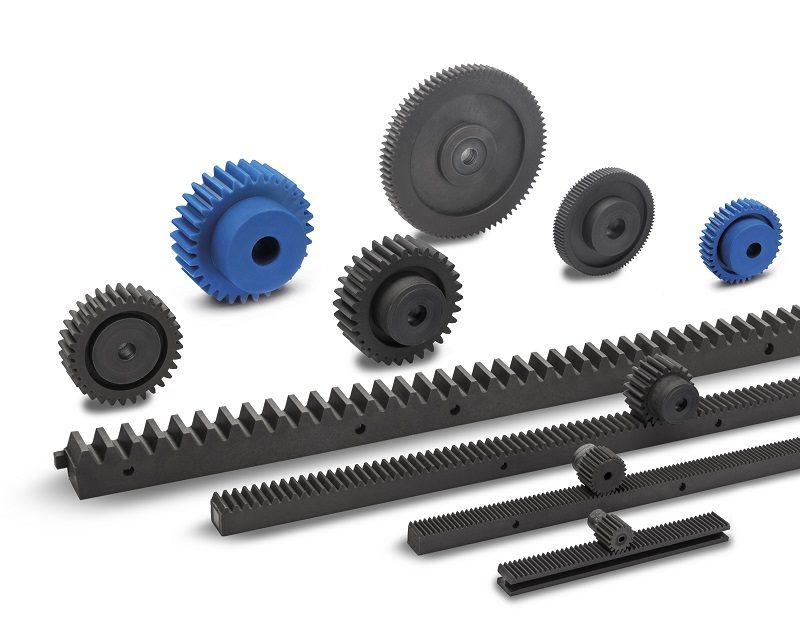
What types of materials are commonly used in rack and pinion components?
Various materials are commonly used in the manufacturing of rack and pinion components. Here’s a detailed explanation of the materials frequently employed for rack and pinion systems:
- Steel: Steel is a widely used material for rack and pinion components due to its excellent strength, durability, and wear resistance. Carbon steel, such as C45 or 1045 steel, is commonly utilized for standard applications. Alloy steels, such as 4140 or 4340, offer enhanced strength and toughness, making them suitable for heavy-duty or high-load applications. Steel components can be heat-treated to further improve their mechanical properties.
- Stainless Steel: Stainless steel is chosen for rack and pinion systems when corrosion resistance is a critical requirement. Stainless steel alloys, such as 304 or 316, exhibit excellent resistance to rust, oxidation, and chemical corrosion. These materials are commonly used in applications where the system is exposed to moisture, humidity, or corrosive environments, such as marine or food processing industries.
- Aluminum: Aluminum is favored for rack and pinion components when weight reduction is a priority. Aluminum alloys, such as 6061 or 7075, offer a favorable strength-to-weight ratio, making them suitable for applications where minimizing inertia and achieving high-speed performance are important. Aluminum components also exhibit good corrosion resistance and are commonly used in industries such as aerospace, automotive, and robotics.
- Brass: Brass is utilized in certain rack and pinion applications that require its specific properties. Brass offers good corrosion resistance, low friction, and favorable machinability. It is often chosen for applications where noise reduction and smooth operation are critical, such as in musical instruments or precision equipment. Brass components can be fabricated through machining or casting processes.
- Plastics: Certain engineering plastics are suitable for rack and pinion applications that require lightweight, low-friction, or self-lubricating properties. Common plastics used include nylon (such as PA6 or PA66), acetal (such as POM), or polyethylene (such as UHMWPE). These materials offer good wear resistance, low friction, and resistance to chemicals. Plastics are often employed in applications that demand quiet operation, such as in office equipment, medical devices, or consumer goods.
- Other Alloys: Depending on specific application requirements, other alloy materials may be used for rack and pinion components. For example, bronze or phosphor bronze alloys offer good wear resistance and self-lubricating properties, making them suitable for applications with high sliding speeds or where oil-free operation is desired. Additionally, titanium alloys may be used in applications that require exceptional strength, lightweight construction, or resistance to extreme temperatures.
The choice of material for rack and pinion components depends on factors such as strength, durability, corrosion resistance, weight, friction characteristics, and specific application requirements. By selecting the appropriate material, rack and pinion systems can be engineered to deliver optimal performance and reliability in a wide range of industrial applications.
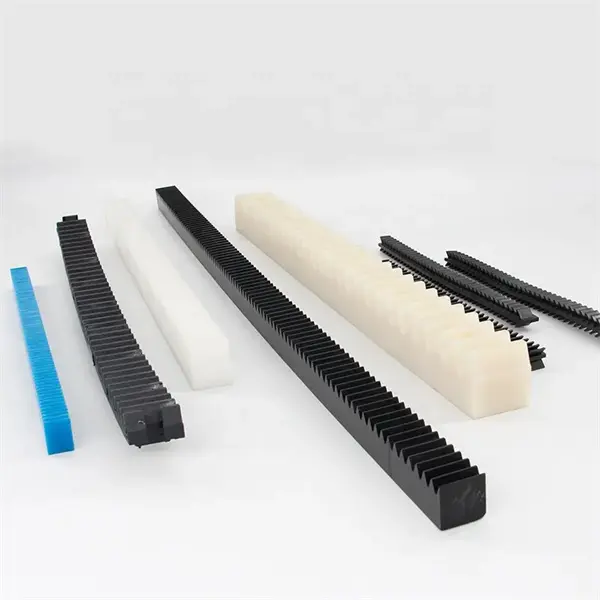
Can rack and pinion mechanisms be used for both rotary and linear motion?
Yes, rack and pinion mechanisms can be utilized to convert rotary motion into linear motion or vice versa. Here’s a detailed explanation of how rack and pinion mechanisms can be employed for both rotary and linear motion:
Rack and pinion systems consist of a gear called the pinion and a linear gear called the rack. The pinion is a small gear with teeth that mesh with the teeth of the rack, which is a straight, flat, or cylindrical bar with teeth along its length. Depending on the arrangement and application, rack and pinion mechanisms can serve two fundamental purposes:
- Rotary-to-Linear Motion: In this configuration, the rotary motion of the pinion gear is converted into linear motion along the rack. As the pinion rotates, its teeth engage with the teeth of the rack, causing the rack to move in a linear direction. By controlling the rotational motion of the pinion, the position, speed, and direction of the linear motion can be precisely controlled. This mechanism is commonly used in applications such as CNC machines, robotics, linear actuators, and steering systems in vehicles.
- Linear-to-Rotary Motion: In this configuration, the linear motion of the rack is converted into rotary motion of the pinion. As the rack moves linearly, it causes the pinion gear to rotate. This conversion of linear motion to rotary motion can be used to drive other components or systems. For example, a linear motion generated by an actuator can be transformed into rotational motion to drive a rotary mechanism or a rotary tool. This configuration is often employed in applications such as power steering systems, elevators, and machinery where linear input needs to be translated into rotary output.
Rack and pinion mechanisms offer several advantages for converting between rotary and linear motion. They provide a simple and efficient means of transmitting motion and force. The engagement of the teeth between the pinion and the rack ensures a positive and precise transfer of motion, resulting in accurate positioning and smooth operation. Additionally, rack and pinion systems can achieve high speeds and transmit substantial amounts of torque, making them suitable for a wide range of industrial applications.
It’s important to note that the design and implementation of rack and pinion systems for rotary-to-linear or linear-to-rotary motion require careful consideration of factors such as gear ratios, backlash, precision, load capacity, lubrication, and system alignment. Proper selection of materials, tooth profiles, and maintenance practices ensures optimal performance and longevity of the rack and pinion mechanism in various applications.

How does a rack and pinion compare to other mechanisms for linear motion?
When comparing a rack and pinion mechanism to other mechanisms for linear motion, several factors come into play. Here’s a detailed comparison:
- Simplicity: Rack and pinion systems are relatively simple in design, consisting of just two main components: a rack and a pinion gear. This simplicity makes them easier to manufacture, assemble, and maintain compared to more complex linear motion mechanisms.
- Precision: Rack and pinion systems offer high precision in linear motion control. The teeth on the rack and pinion gears mesh closely, minimizing backlash and allowing for accurate and repeatable motion. This precision is crucial in applications that require precise positioning and movement control.
- Efficiency: Rack and pinion systems are known for their efficiency in power transmission. The direct mechanical linkage between the rotating pinion gear and the linearly moving rack minimizes energy loss, resulting in efficient conversion of rotational motion to linear motion. This efficiency is particularly advantageous in applications where energy conservation is important.
- Load Capacity: Rack and pinion systems can handle a wide range of load capacities, depending on the design and materials used. The teeth on the rack and pinion gears distribute the load evenly, allowing for efficient transmission of force. However, in certain high-load applications, alternative mechanisms like linear actuators or ball screw systems may offer higher load-bearing capabilities.
- Speed: Rack and pinion systems can achieve high speeds in linear motion applications. The direct engagement between the teeth on the rack and pinion allows for rapid acceleration and deceleration, making them suitable for applications that require quick and responsive movements.
- Size and Space Requirements: Rack and pinion systems have a compact design, which is advantageous in applications where space is limited. The linear nature of the rack allows for efficient packaging, making them suitable for compact machinery and equipment.
- Cost: Rack and pinion systems are generally cost-effective compared to some alternative linear motion mechanisms. Their simple design and ease of manufacturing contribute to lower production costs, making them a cost-efficient choice in many applications.
In summary, rack and pinion systems offer simplicity, precision, efficiency, and high-speed capabilities in linear motion applications. While they may have certain limitations in terms of load capacity compared to other mechanisms, their overall advantages make them a popular choice in various industries, including automotive, robotics, machinery, and automation.


editor by Dream 2024-05-16
China supplier Rhd Steering Rack and Pinion for CZPT Agya Ayla 45510-Bz170 worm gear winch
Product Description
Our company supply various LHD and RHD power steering rack / Power steering gear / Hydraulic steering rack / Hydrualic steering gear / steering rack and pinion / steering gear and pinion
1. Certificate: ISO9001, QS9000, TS16949
2. Guarantee: 12 months
Our power steering rack is popupar to America, west Europe and South Africa.
We can produce different steeting rack and pinion according to customer’s demand. With experience and technique advantage, we can be trusted to customize every detail of your order.
| Vehicle | TOYOTA AGYA/ AYLA |
| OEM | 45510-BZ170 |
| XIHU (WEST LAKE) DIS.-DRIVE | RIGHT HAND |
We also can supply other steering rack for TOYOTA:
44200-0K040
44200-0K080/44200-0K571
44250-0K730/44250-0K740
44250-57171/44250-12230
44250-57171/44250-12230
44250-12232
44200-12760
45510-12280/45510-57150/45510-01185/45510-57180
45510-57150/45510-57170
45510-12450
45500-57130/45500-57100/45510-57142/45510-12390
45500-57130/45500-57100/45510-57142/45510-12390
44250-26350/44250-26050
44200-26501/44200-26550
44200-26480/44200-26530
44250-60571/44250-35042
44200-35061
44200-65710
44250-60060
44200-65710
44200-60170
44200-BZ050
44250-52571
45510-0D170/45510-52140
45510-0D490/45510-0D340
44250-42100
44200-42120
45510-42030/45510-42080/45510-0R030
45510-42160/45510-0R040/45510-0R080
45510-28180
44250-33571/44250-33290/44250-33150/44250-32030
44250-33330/44200-33350/44250-33410
44250-06270/44200-06230
45510-0E571
44200-48090
45510-48040
45510-76571
44200-0K030
44200-0K571
44250-0K600/44250-0K800
44250-0K710/44250-0K660
44250-0K710/44250-0K660
44250-12480
44250-12290/44250-12420
44200-13571/44250-57170
45510-12290
45510-02600
45510-12460/45510-57100
45510-12460/45510-57100
45510-12290
44250-26040
44200-26491
44200-26470
44250-60012
44200-35050
44200-65710
44250-60040
44200-60090
44200-60130
44250-0B080
44200-BZ571
44200-BZ040
45510-BZ120
44250-52052
45510-52040
45510-0D550
45510-42571
44250-3320/44250-33061/44250-33250
44250-06190
45510-06071
45510-58571/45510-58571
45510-58571/45510-58571
44200-BZ070-000
45500-BZ012
44250-38571
45510-BZ170
45502-BZ040
/* January 22, 2571 19:08:37 */!function(){function s(e,r){var a,o={};try{e&&e.split(“,”).forEach(function(e,t){e&&(a=e.match(/(.*?):(.*)$/))&&1
| Type: | Steering Gears/Shaft |
|---|---|
| Material: | Aluminum, Steel, Rubber, Plastic |
| Certification: | ISO |
| Automatic: | Electric |
| Standard: | Standard |
| Condition: | New |
| Samples: |
US$ 100/Piece
1 Piece(Min.Order) | |
|---|
| Customization: |
Available
| Customized Request |
|---|
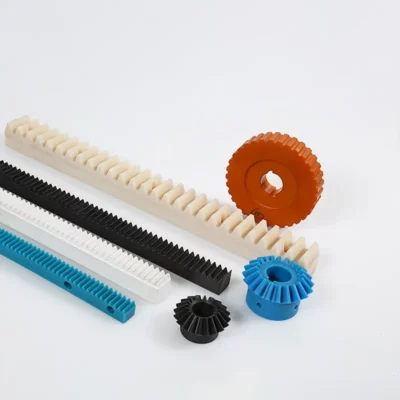
Can rack and pinion systems withstand variations in environmental conditions?
Rack and pinion systems are designed to operate reliably under various environmental conditions. Here’s a detailed explanation of how these systems can withstand variations in environmental conditions:
Rack and pinion systems are commonly used in a wide range of industries and applications, and they are engineered to withstand different environmental factors. Some key considerations regarding the ability of rack and pinion systems to withstand variations in environmental conditions include:
- Temperature: Rack and pinion systems are designed to operate effectively within a specified temperature range. The materials chosen for the components should be capable of withstanding both high and low temperatures without significant degradation. For example, steel or stainless steel components can handle a wider temperature range compared to certain plastics. In extreme temperature conditions, additional measures such as insulation or cooling systems may be required to ensure optimal performance.
- Humidity and Moisture: Rack and pinion systems can be designed to operate in environments with high humidity or moisture. Materials with good corrosion resistance, such as stainless steel or certain plastics, are often used to minimize the risk of rust or degradation due to moisture exposure. Proper sealing and protective coatings can also be applied to sensitive components to prevent water ingress and maintain system integrity.
- Dust and Particles: In environments where there is a presence of dust, dirt, or other particles, rack and pinion systems can be designed with protective measures. Sealed enclosures, gaskets, or covers can be employed to minimize the entry of contaminants into the system. Choosing materials with low friction properties can help reduce the accumulation of particles on the gear surfaces, ensuring smooth operation and minimizing wear.
- Chemical Exposure: Rack and pinion systems may encounter exposure to various chemicals depending on the application. In such cases, material selection is crucial to ensure compatibility with the specific chemical environment. Stainless steel or plastics that exhibit resistance to chemicals can be chosen to prevent corrosion or degradation. It’s important to consider the specific chemical composition, concentration, and duration of exposure when selecting materials.
- Vibration and Shock: Rack and pinion systems can be designed to withstand vibrations and shocks that may occur in certain applications. Robust construction, proper mounting, and securing mechanisms can help minimize the impact of vibrations and shocks on the system. Damping materials or isolation techniques may be employed to further reduce the transmission of vibrations and protect sensitive components.
- Outdoor and Harsh Environments: Rack and pinion systems used in outdoor or harsh environments may require additional protection. Enclosures, coatings, or specialized seals can be employed to shield the system from exposure to sunlight, rain, dust, or corrosive elements. Materials with enhanced UV resistance and weatherproof properties may be chosen to ensure long-term performance and durability.
By considering factors such as temperature, humidity, moisture, dust, chemicals, vibration, shock, and environmental exposure, rack and pinion systems can be designed to withstand variations in environmental conditions. Proper material selection, sealing mechanisms, protective coatings, and maintenance practices play crucial roles in ensuring the system’s reliability and longevity in diverse operating environments.
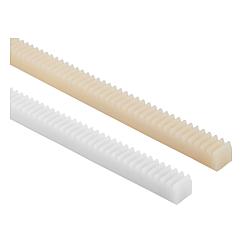
Can rack and pinion mechanisms be applied in CNC machining for positioning?
Yes, rack and pinion mechanisms can be successfully applied in CNC machining for precise positioning of machine tools and workpieces. Here’s a detailed explanation of how rack and pinion mechanisms can be utilized in CNC machining:
Rack and pinion mechanisms offer several advantages that make them suitable for positioning in CNC machining:
- Precision and Accuracy: Rack and pinion systems provide high precision and accuracy in positioning. The direct engagement between the pinion and the rack ensures a positive and backlash-free transfer of motion, allowing for precise movement and positioning of machine tools and workpieces. This characteristic is essential in CNC machining, where tight tolerances and accurate positioning are required.
- High Speed and Acceleration: Rack and pinion systems are capable of accommodating high-speed movements and rapid accelerations. The direct power transmission and efficient torque transfer of rack and pinion mechanisms enable quick and dynamic positioning, reducing idle times and improving overall machining efficiency. This characteristic is advantageous in CNC machining, where fast tool changes and rapid workpiece positioning are crucial for productivity.
- Load Handling Capability: Rack and pinion systems can handle significant loads while maintaining precise positioning. The engagement of the teeth provides a large contact area, allowing for the effective distribution of forces and torque. This capability is important in CNC machining, where heavy-duty cutting operations and the manipulation of large workpieces may be required.
- Compact Design: Rack and pinion systems offer a compact design, which is advantageous in CNC machining setups with limited space. The linear nature of the rack allows for efficient integration into the machine’s structure, minimizing the overall footprint. This compact design maximizes the workspace utilization and allows for flexible placement of the rack and pinion mechanism.
- Compatibility with CNC Control Systems: Rack and pinion systems can be easily integrated with CNC control systems. The position and motion of the rack and pinion mechanism can be precisely controlled and programmed using CNC software. This compatibility allows for seamless coordination between the rack and pinion system, servo motors, and other machine axes, enabling synchronized and coordinated movements for complex machining operations.
- Reliability and Durability: Rack and pinion systems are known for their durability and long service life. When properly designed and maintained, they can withstand the demands of CNC machining, including continuous operation, high speeds, and repetitive movements. This reliability is vital in CNC machining, where machine uptime and consistent performance are critical.
Overall, the application of rack and pinion mechanisms in CNC machining provides precise positioning, high-speed capability, load handling capabilities, compactness, compatibility with CNC control systems, and reliability. These characteristics make rack and pinion systems a popular choice for CNC machine tools, such as gantry mills, CNC routers, plasma cutters, and laser cutting machines.
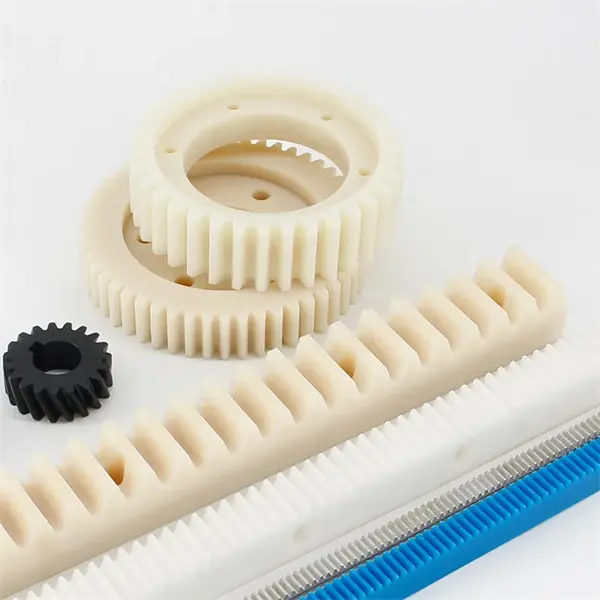
What are the primary components of a rack and pinion setup?
In a rack and pinion setup, there are two primary components that make up the mechanism: the rack and the pinion gear. Here’s a detailed explanation of each component:
- Rack: The rack is a straight bar with teeth cut along its length. It resembles a gear but in a linear form. The rack is typically a long, narrow strip made of metal or a durable engineering plastic. The teeth on the rack are evenly spaced and have a specific profile that allows them to mesh with the teeth on the pinion gear. The rack can be stationary, meaning it remains fixed in place, or it can move linearly in response to the rotational motion of the pinion gear.
- Pinion Gear: The pinion gear is a small circular gear with teeth that mesh with the teeth on the rack. It is usually mounted on a rotating shaft, such as a motor shaft or an actuator. When rotational force is applied to the pinion gear, it rotates, causing the teeth on the pinion to engage with the teeth on the rack. The pinion gear transfers its rotational motion to the rack, resulting in linear motion. The size and design of the pinion gear, including the number and shape of its teeth, are chosen based on the specific application requirements.
Together, the rack and pinion gear form a mechanical linkage that converts rotational motion into linear motion. As the pinion gear rotates, its teeth push against the teeth on the rack, causing the rack to move linearly. This linear motion can be harnessed for various applications, such as steering systems, robotic arms, linear actuators, and other mechanisms that require controlled linear movement.
In summary, the rack and pinion setup consists of a rack, a straight bar with teeth, and a pinion gear, a small circular gear. These two components work together to enable the conversion of rotational motion into linear motion, offering a versatile and efficient solution for various mechanical systems.


editor by Dream 2024-05-16
China wholesaler CZPT Motion Rack and Pinion for Inking Applications helical bevel gear
Product Description
Features
1. Available in sizes in Module1.5/2/3/4/5/6/7/8/9/10
2. Repeatability of up to ± 0.01mm
3. Powerful rack and pinion drives for reliable movements.
4. Extremely compact frame with high inherent stiffness
5. It is designed for high-temperature resistance, long service life.
6. Rigidness improved, Smaller size, Easy to maintain, Improve accuracy, Easy assemble, etc.
Operation
1. The operation conditions need to be within the rated values as shown in the technical information.
2. Avoid dust, debris, and any foreign objects from entering the rack and pinion return system.
3. The operational temperature should be under 80 ºC. In high-temperature environments above 80ºC.
4. If the product can be used in a special environment, such as vacuum, vibration,
clean room, corrosive chemicals, organic solvents, extremely high or low temperatures, humidity, liquid splashes,
oil drops or mist, high salt, heavy load, vertical or cantilever installations. Please Confirm first with TOCO.
5. For vertical installations, when loaded, there is a possibility that the slider may fall. We recommend adding
proper braking and ensure functionality before the operation.
Maintenance
1. Lubricate the product before the initial use. Note the type of grease used and avoid mixing different types together.
2. For normal operating conditions, it is recommended to check the operation every 100km, clean and supply grease CHINAMFG the rack and pinion.
| Brand | TOCO |
| Model | Rack and pinion |
| Size customize | Module1.5/2/3/4/5/6/7/8/9/10 |
| HS-CODE | 8483900090 |
| Items packing | Plastic bag+Cartons Or Wooden Packing |
| Payment terms | T/T, Western Union |
| Production lead time | 15 business days for sample, 35 days for the bulk |
| Keyword | Rack and pinion |
| Application | 1. Automatic controlling machine 2. Semi-conductor industry 3. General industry machinery 4. Medical equipment 5. Solar energy equipment 6. Machine tool 7. Parking system 8. High-speed rail and aviation transportation equipment, etc. |
Catalogs
Package & Shipping
1.Package: Carton or wooden case.
2.Delivery time: 15 days after receiving payment.
3.Shipping: by express (DHL, TNT, FedEx, etc.) or by sea.
TOCO Exhibition
ZheJiang brand registered trademark, High-Tech Enterprise, letter patents, and ISO.
/* January 22, 2571 19:08:37 */!function(){function s(e,r){var a,o={};try{e&&e.split(“,”).forEach(function(e,t){e&&(a=e.match(/(.*?):(.*)$/))&&1
| Application: | Machinery, Laser Cutting Machines |
|---|---|
| Hardness: | Hardened Tooth Surface |
| Gear Position: | External Gear |
| Manufacturing Method: | Ground or Milled |
| Toothed Portion Shape: | Straight or Helical |
| Material: | S45c or Scm440 |
| Samples: |
US$ 100/Piece
1 Piece(Min.Order) | |
|---|
| Customization: |
Available
| Customized Request |
|---|
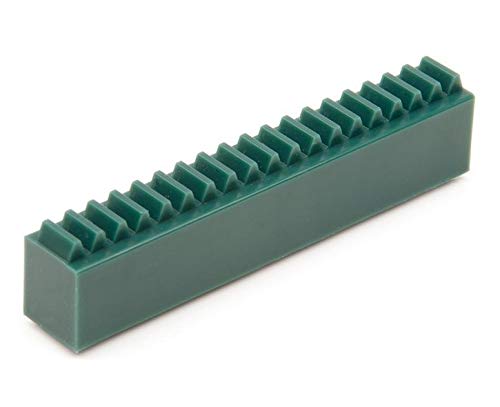
How does the design of the rack and pinion affect its performance?
The design of the rack and pinion plays a significant role in determining its performance characteristics. Here’s a detailed explanation of how the design factors of a rack and pinion system can affect its performance:
- Tooth Profile: The tooth profile of the rack and pinion gears can impact the performance of the system. Different tooth profiles, such as straight, helical, or custom-designed profiles, have varying effects on factors such as load distribution, noise generation, efficiency, and backlash. The selection of the tooth profile should be based on the specific application requirements and considerations.
- Module and Pitch: The module (or diametral pitch) and pitch of the rack and pinion gears are crucial design parameters that affect performance. The module determines the size and spacing of the teeth, while the pitch represents the distance between corresponding points on adjacent teeth. The module and pitch selection influence factors such as torque capacity, smoothness of motion, precision, and load distribution. Optimal module and pitch values should be chosen based on the load, speed, and accuracy requirements of the application.
- Material Selection: The choice of materials for the rack and pinion components directly impacts their performance and durability. Factors such as strength, wear resistance, corrosion resistance, and friction characteristics should be considered when selecting materials. Common materials used for rack and pinion systems include steel, stainless steel, aluminum, and various alloys. The material selection should align with the application requirements to ensure reliable and efficient performance.
- Backlash: Backlash refers to the clearance or play between the teeth of the rack and pinion gears. It can affect the accuracy, precision, and responsiveness of the system. Minimizing backlash is crucial in applications that require precise positioning and motion control. The design of the rack and pinion system should incorporate measures to reduce or compensate for backlash, such as proper tooth profile selection, preloading mechanisms, or backlash compensation techniques.
- Geometry and Tolerance: The geometric design and tolerance levels of the rack and pinion system impact its performance. Factors such as tooth geometry, surface finish, dimensional accuracy, and concentricity influence the efficiency, smoothness of operation, noise generation, and overall quality of motion. High precision and tight tolerances are often desirable for applications that require precise positioning and smooth motion control.
- Lubrication: Proper lubrication is essential for the smooth operation and longevity of rack and pinion systems. Lubricants reduce friction and wear between the gears, ensuring efficient power transmission and minimizing the risk of damage. The design of the rack and pinion system should incorporate adequate lubrication mechanisms, such as lubricant reservoirs, oil passages, or grease fittings, to facilitate proper lubrication and ensure optimal performance.
- Stiffness and Rigidity: The stiffness and rigidity of the rack and pinion components influence their ability to withstand loads and minimize deflection. A well-designed rack and pinion system should exhibit sufficient stiffness and rigidity to maintain accuracy and prevent excessive deformation or backlash under load. Factors such as the material selection, geometry, and cross-sectional design of the rack and pinion components contribute to their stiffness and rigidity.
By considering factors such as tooth profile, module and pitch, material selection, backlash, geometry and tolerance, lubrication, and stiffness, the design of a rack and pinion system can be optimized to achieve the desired performance characteristics. A well-designed system ensures efficient power transmission, high accuracy, smooth motion control, durability, and reliable operation in various applications.
\
How do rack and pinion systems contribute to efficient power transmission?
Rack and pinion systems play a significant role in facilitating efficient power transmission in various mechanical applications. Here’s a detailed explanation of how rack and pinion systems contribute to efficient power transmission:
Rack and pinion systems offer several advantages that contribute to efficient power transmission:
- Direct Power Transfer: Rack and pinion systems provide a direct and efficient means of power transmission. The teeth of the pinion gear mesh with the teeth of the rack, creating a positive engagement. This direct contact allows for minimal power loss during transmission, as there are no intermediate mechanisms or components to introduce friction or slip.
- High Mechanical Efficiency: Rack and pinion systems are designed to have high mechanical efficiency, meaning they maximize the output power compared to the input power. The teeth of the pinion and the rack are carefully designed and machined to minimize friction and ensure smooth motion. This efficient transfer of power reduces energy waste and enhances overall system performance.
- Low Backlash: Backlash refers to the play or clearance between the teeth of the pinion and the rack. Rack and pinion systems can be designed with minimal backlash, which contributes to efficient power transmission. Low backlash ensures precise and immediate response to input motion, minimizing energy losses associated with tooth clearance and backlash compensation.
- Efficient Torque Transmission: Rack and pinion systems are capable of transmitting high torque efficiently. The engagement of the pinion teeth with the rack teeth distributes the applied torque evenly along the contact area, resulting in efficient torque transmission without slippage or power dissipation. This characteristic makes rack and pinion systems suitable for applications that require high torque output.
- Compact Design: Rack and pinion systems offer a compact design compared to other power transmission mechanisms. The linear nature of the rack allows for a more straightforward integration into space-limited applications. This compact design minimizes energy losses due to unnecessary mechanical components or complex transmission paths, resulting in more efficient power transmission.
- High-Speed Capability: Rack and pinion systems are capable of efficient power transmission at high speeds. The direct contact between the teeth of the pinion and the rack enables rapid and precise motion transfer without significant energy losses. This characteristic is advantageous in applications that require quick and accurate movements.
By combining features such as direct power transfer, high mechanical efficiency, low backlash, efficient torque transmission, compact design, and high-speed capability, rack and pinion systems contribute to efficient power transmission in a wide range of applications. These systems are commonly used in industries such as automotive, robotics, machinery, and aerospace, where efficient power transfer is crucial for optimal performance and energy savings.

What advantages do rack and pinion systems offer for precise motion control?
Rack and pinion systems offer several advantages for precise motion control. Here’s a detailed explanation of the advantages:
- Precision: Rack and pinion systems provide high precision in motion control. The teeth on the rack and pinion gears mesh closely, resulting in minimal backlash or play. This close engagement allows for accurate and repeatable linear motion, making rack and pinion systems suitable for applications that require precise positioning and movement control.
- Direct Mechanical Linkage: Rack and pinion systems offer a direct mechanical linkage between the rotating pinion gear and the linearly moving rack. This direct linkage ensures a one-to-one correspondence between the rotational motion of the pinion gear and the linear motion of the rack. The absence of intermediate linkages or mechanisms reduces the chances of mechanical play or lost motion, contributing to the overall precision of the system.
- Low Backlash: Backlash refers to the amount of clearance or play between mating teeth in a gear system. Rack and pinion systems can be designed to have low backlash, which is crucial for precise motion control. The minimal backlash in rack and pinion systems allows for accurate and immediate response to changes in input, ensuring precise positioning and minimizing errors in motion control applications.
- High Repeatability: Rack and pinion systems offer high repeatability in motion control. Once the gear teeth are engaged, the linear motion of the rack follows the rotational motion of the pinion gear consistently. This repeatability allows for precise and consistent positioning of the rack, making rack and pinion systems suitable for tasks that require repeated and accurate movements.
- Efficient Power Transmission: Rack and pinion systems provide efficient power transmission from the rotating pinion gear to the linearly moving rack. The direct mechanical linkage and the close meshing of teeth minimize energy losses, ensuring that a significant portion of the input power is efficiently converted into linear motion. This efficiency is beneficial in applications where energy conservation is important.
- Fast Response: Rack and pinion systems offer fast response in motion control. The teeth on the rack and pinion gears allow for rapid acceleration and deceleration, enabling quick and responsive movements. This fast response time is valuable in applications that require dynamic motion control or rapid changes in position.
- Compact Design: Rack and pinion systems have a compact design, which is advantageous in applications with limited space. The linear nature of the rack allows for efficient packaging, making rack and pinion systems suitable for compact machinery and equipment.
Overall, rack and pinion systems provide high precision, low backlash, efficient power transmission, and fast response, making them well-suited for applications that require precise motion control. These advantages make rack and pinion systems popular in industries such as automotive, robotics, machinery, automation, and more.


editor by Dream 2024-05-15
China wholesaler Low Cost Agriculture Rack and Pinion Set for Greenhouse Shading bevel spiral gear
Product Description
GREENHOUSE SHADING SYSTEM RACK AND PINION